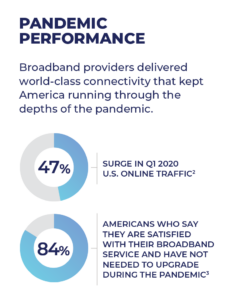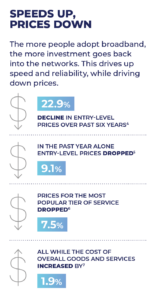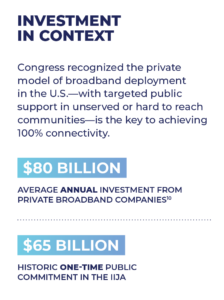February 10, 2022
A Blueprint for Government to Finally and Fully Connect Our Nation
TO:
President Joe Biden
Vice President Kamala Harris
U.S. Treasury Secretary Janet Yellen
U.S. Commerce Secretary Gina Raimondo
U.S. Agriculture Secretary Tom Vilsack
NTIA Administrator Alan Davidson
Chairwoman Jessica Rosenworcel and FCC Commissioners
Members of House and Senate
America’s Governors, Mayors, and Local Leaders
Tribal Leaders
State Broadband Offices
FROM:
America’s Broadband Providers
RE:
Making the Most of America’s $65 Billion Broadband Investment
In November, Congress passed the Infrastructure Investment & Jobs Act (IIJA)—a generational opportunity to advance U.S. infrastructure. This included $65 billion to connect unserved and underserved communities to modern, high-speed internet and ensure low-income Americans can afford access to broadband. Combine this public commitment with the $80 billion private broadband providers invest each year in U.S. digital infrastructure, and our nation has a fighting chance to finally and fully achieve universal connectivity.
Connecting every American, regardless of geography or income, will require unprecedented collaboration across the private and public sectors, spanning federal, state, Tribal and local governments. Getting the details right will ultimately make (or break) this work. What follows is a roadmap for how public decision makers, and their broadband partners, can make true, universal connectivity a reality for every person in every community across our country.
The most important decision a community can make is to partner with experienced providers to ensure funds spent today will not only complete a network build, but continue to provide communities modern, reliable connectivity well into the future.
VALUE EXPERIENCE
 Broadband deployment is hard, complicated, and expensive work. It’s also not a ‘set it and forget it’ technology. Congress was clear: competition for these public funds should occur on a level playing field. Yet concerning rules have emerged from the Treasury and Agriculture Departments that encourage states to favor entities like non-profits and municipalities when choosing grant winners, despite their well-documented propensity to fail at building and maintaining complex networks over time. The unconnected—not to mention American taxpayers—can’t take that gamble. Experience should not be a mark against an applicant, but a strong attribute in their corner.
Broadband deployment is hard, complicated, and expensive work. It’s also not a ‘set it and forget it’ technology. Congress was clear: competition for these public funds should occur on a level playing field. Yet concerning rules have emerged from the Treasury and Agriculture Departments that encourage states to favor entities like non-profits and municipalities when choosing grant winners, despite their well-documented propensity to fail at building and maintaining complex networks over time. The unconnected—not to mention American taxpayers—can’t take that gamble. Experience should not be a mark against an applicant, but a strong attribute in their corner.
- Rescind recent federal grant guidance that expresses a clear preference for networks built by municipalities, non-profits and electric co-ops.
- Consistent with the intent of Congress, funding decisions should be based solely on how best to connect unserved and underserved Americans, not on a provider’s status as a public or private entity.
- Require the same demonstrations of broadband experience and financial wherewithal from both public and private entities.
Communities that want to offer their own connected services should partner with local broadband providers in order to leverage their expertise and capabilities.
U.S. broadband networks have performed very well, particularly when compared to those of the European Union and the OECD. Three factors that may account for that are the high level of investment in telecommunications by U.S. carriers, the prevalence of high-speed fixed-broadband networks in the U.S., and a light-touch regulatory environment.”
– Anna-Maria Kovacs, Ph.D., MBA, Visiting Senior Policy Scholar at the Georgetown Center for Business and Public Policy[1]
ADVANCE AFFORDABILITY
To achieve true universal connectivity, all Americans need access to broadband infrastructure, no matter their income. This means investing as a nation not just in broadband deployment, but broadband adoption. The Infrastructure Act created the Affordable Connectivity Program (ACP). Similar to housing and food assistance, this digital safety net offers a monthly discount of up to $30/month ($75/month on Tribal lands) to help those struggling financially get, and stay, connected.
- Provider participation in the ACP should satisfy requirements to offer a low-cost service offering to receive infrastructure funds.
- States and communities should also make use of federal funds available to encourage digital literacy and adoption. Making broadband relevant and approachable for those who have limited history with the service is essential to universal connectivity.
REMOVE ROADBLOCKS
 In addition to distributing infrastructure funds, state and local leaders can provide additional connectivity support by removing state or local deployment hurdles—from permitting delays to excessive fees—that unnecessarily impede progress.
In addition to distributing infrastructure funds, state and local leaders can provide additional connectivity support by removing state or local deployment hurdles—from permitting delays to excessive fees—that unnecessarily impede progress.
- States and communities should ensure their rights-of-way and permitting processes are as streamlined as possible.
- State broadband leaders should also serve as a liaison with other branches of government (e.g., departments of transportation) and easement holders like railroads to ensure similar streamlining.
- Congress should review disparate nationwide practices, including discriminatory and anti-competitive pole attachment policies that allow municipalities and electric cooperatives to enter the broadband business without any federal regulation of their pole attachment rates and practices (unlike their competitors).
- Congress, states and the FCC should eliminate burdensome rules that only apply to incumbent providers once the government has subsidized a new provider to serve the same area.
ADD EXPERTISE
Federal officials are upfront that managing a commitment of this scale requires expertise they still need to acquire. In a single year, NTIA will need to quickly evolve from a lean organization with an annual budget of only $72 million to an organization capable of quickly, efficiently and effectively distributing the lion’s share of the $65 billion in public funds. Federal agencies must prioritize hiring program administrators with strong financial, operational and technical expertise managing endeavors of this size and complexity.
CRAFT POLICIES FOR 2022…NOT 1996
As the nation races forward with deployment efforts, policymakers should avoid throwing up new regulatory hurdles that undercut this progress. The endless net neutrality and Title II regulation debates that captivate a tiny subsection of Washington in reality have little or no bearing on modern connectivity. Regulating broadband providers like utilities would slow deployment, tamp down investment, potentially drive up consumer prices (see your heating bill in winter) and make it more difficult for U.S. networks to keep pace with innovation. This approach also fails to address consumers’ actual concerns with the internet today, which relate primarily to the practices of social media and other edge providers.
- Reject Title II utility regulation of broadband networks.
- Adopt national net neutrality and consumer privacy laws that apply equitably across the internet ecosystem.
- Update Universal Service Fund rules to reflect today’s marketplace and ensure all major online players contribute their fair share to the costs of broadband deployment and adoption.
SPEND CAREFULLY AND EFFICIENTLY
 While this is an unprecedented federal funding commitment, this support is finite. It’s imperative that care is taken to ensure deployment funds go to their intended use—connecting unserved and underserved Americans. Fortunately, resources exist to help target funds in this manner to maximize outcomes for communities.
While this is an unprecedented federal funding commitment, this support is finite. It’s imperative that care is taken to ensure deployment funds go to their intended use—connecting unserved and underserved Americans. Fortunately, resources exist to help target funds in this manner to maximize outcomes for communities.
- States should use the FCC’s soon to be available (and Congressionally-mandated) broadband mapping data and capabilities to target finite federal funds to unserved and underserved areas.
- States should think holistically about broadband plans to allow for the best network design that will bring broadband to the most people across eligible areas.
The combination of these historic public funds from Congress, along with massive, annual private investments by U.S. broadband providers offers an historic opportunity to finally and fully connect all Americans to high-speed broadband. USTelecom member companies stand ready to meet this moment. We will continue to upgrade and extend our networks to bring high-speed fiber and 5G wireless infrastructure to every community. And, we are committed to serving everyone. This is good business and good values.
With the government stepping up for low-income families and high-cost areas, we have the possibility of a sustainable path forward. Broadband companies stand ready to link arms with policymakers at the federal, state, local and Tribal levels and get the job done. You can find more information and further resources at ustelecom.org.
ENDNOTES
1 www.ustelecom.org/wp-content/uploads/2020/06/PP-2020-06-Kovacs-internet-performance.pdf.
2 www.fiercetelecom.com/operators/due-to-covid-19-broadband-usage-spikes-47-q1-nearly-surpassing-all-2020-s-projections
3 www.consomerreports.org
4 ustelecom.org/across-the-spectrum-entry-level-broadband-prices-declining/
5 ustelecom.org/across-the-spectrum-entry-level-broadband-prices-declining
6 www.ustelecom.org/no-fluke-american-broadband-prices-continue-decline-in-2021/
7 www.ustelecom.org/no-fluke-american-broadband-prices-continue-decline-in-2021/
8 ustelecom.org/research/2020-broadband-capex-report/